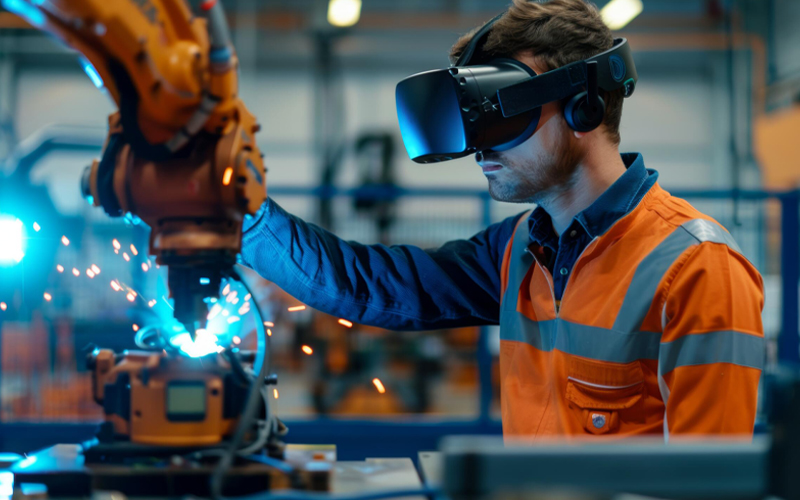Steam gave rise to the original industrial revolution; electricity was the conduit for the second; preliminary automation and machinery were the architects of the third; and intelligent computing is the force behind the fourth industrial revolution. Industry 4.0 is the era of digitisation of the manufacturing sector through connectivity, advanced analytics, automation, and advanced manufacturing technology. This transformation started in the mid-2010s in manufacturing and holds significant potential for the future.
Smart factories integrate robotics, IoT sensors, cloud computing, big data, and AI to increase production and reduce downtime. Combining data from production with data from ERP, supply chain, CRM, and other operational systems will enable comprehensive insights that improve decision-making, build resilience, and generate value. Despite the known and proven benefits, the manufacturing industry has been slow in implementing digital technologies at scale. Close to 70% of the manufacturers who have invested in digitalisation have struggled to move beyond the pilot phase.
There are many challenges to achieving a digital plant floor, but the returns are worth persevering for. So, what are the hurdles in metamorphosing into an intelligent plant?
Challenges
Focusing on the technology rather than analysing business needs and value-adds will result in the deployment being just an installation, not a solution. The implementation will lack linkage to specific business challenges or value-added opportunities, denting workforce confidence in the transformation. At the outset, it is impossible to know many of the aspects involved in digital transformation. Drawing up inflexible, extensively scaled, and minutely detailed plans is impractical and could lead to failure.
A siloed implementation occurs when the delivery teams do not have cross-functional representation, narrowing the project outreach and overlooking the concerns of important stakeholders. Not considering the broader network complexities beyond the dynamics of a single site is another instance of forming silos.
Multinational corporations with factories in multiple geographies must customise each location's digitalisation effort to create value. A one-size-fits-all approach is a missed opportunity to harness a site's unique culture, dynamics, and ethos.
Digital transformation is a technological and cultural journey built on the collaborative effort of employees at all levels. If the organisation does not base the change management strategy on employee input and concerns, the initiative is bound to fail. Workforce engagement and skill upgradation determine the speed and success of the deployment.
Having an extraordinarily detailed up-front analysis but no effort to section the project into manageable chunks causes analysis paralysis. The next step is buried away under the overwhelming technicalities of the analysis. It's a similar scenario when establishing the ideal data, operational, and information architecture is emphasised before deploying the industry 4.0 solutions. Scope creep is inevitable, and the project is at risk of being run into the ground.
Navigating the Challenges
Organisations initially need to list high-priority and high-value-add technology use cases, based on data readiness and IT and operational maturity, to find possibilities for big and quick wins. These wins would then pave the way for the digital transformation as they would demonstrate the feasibility and the value. As the initiative progresses with the initial use cases, building a road map with manageable milestones is imperative. Each milestone should capture financial and operational value, boost engagement and buy-in, and convert quickly into a competitive advantage. An agile approach with continuous iterations helps organisations learn from failures, scale quickly, and build digital literacy.
Estimate the total value at stake by grouping prioritised use cases to align business leaders on the vision. An engaging visual presentation of the solutions can form a compelling change story for the wider organisation to get them on board with the vision. Submitting the business case and requirements to important stakeholders is vital to gaining a clear mandate from leaders and aligning site heads on targets and execution.
Using cross-functional teams that cover all relevant functions and are authorised to study all processes, systems, and databases is vital to break up silos. Broad employee participation at all levels is crucial to prevent resistance to change. A platform to discuss uncertainties, provide feedback, and report issues is essential. Addressing the issues is the key to building credibility. Setting up a cross-functional core team, an effective engagement plan for site leaders, and regular update sessions with senior management will prove invaluable to ensure that all concerned parties are on the same page.
New technology might be a challenge for plant floor operators who have little to no familiarity with it. Training for front-line operators without previous experience working with digital equipment should include repeated simple walkthroughs before moving on to more intense sessions. Step-by-step instructions with visual aids and easily accessible FAQs are handy for the transition period.
Industrial digitalisation isn't about giving a makeover to the production setup; it is about revolutionising business outcomes. Digital transformation is essential for future-proofing organisations.
*For organizations on the digital transformation journey, agility is key in responding to a rapidly changing technology and business landscape. Now more than ever, it is crucial to deliver and exceed on organizational expectations with a robust digital mindset backed by innovation. Enabling businesses to sense, learn, respond, and evolve like a living organism, will be imperative for business excellence going forward. A comprehensive, yet modular suite of services is doing exactly that. Equipping organizations with intuitive decision-making automatically at scale, actionable insights based on real-time solutions, anytime/anywhere experience, and in-depth data visibility across functions leading to hyper-productivity, Live Enterprise is building connected organizations that are innovating collaboratively for the future.







